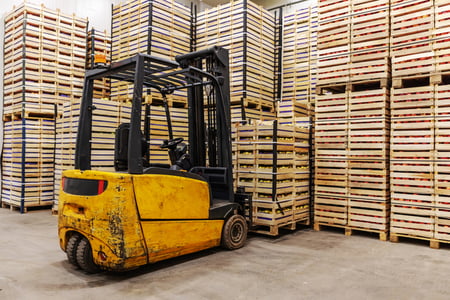 Cold storage facilities are critical to any number of supply chains. At the same time, they can be downright brutal on material handling equipment. This includes the forklifts needed to manage the foods, healthcare products, and other goods that demand a chilled environment.
Cold storage facilities are critical to any number of supply chains. At the same time, they can be downright brutal on material handling equipment. This includes the forklifts needed to manage the foods, healthcare products, and other goods that demand a chilled environment.
Designing and managing a cold storage forklift power system--especially a freezer system--is radically different than your run-of-the-mill setup. That’s because temperature variations not only affect voltages/capacity, extreme cold can damage the equipment at a much faster rate.
When cold storage power is designed and maintained properly, a company can increase asset lifespan by 30-50%, while eliminating troublesome downtime events.
Power systems are constantly evolving and it’s hard to keep up if that’s not your main area of expertise. For example, you’ve probably heard buzz that lithium and fuel cell are the right approaches. In some cases, that’s true. But to know for sure, you should conduct a detailed power assessment of your facility (including the cold storage needs). Next, you should evaluate the cost profiles of a lead acid system versus newer technology to see which helps you come out ahead. And finally, your maintenance should be designed to prolong the asset lifespan.
When it comes to cold storage, power counts. You can see why it pays to set your system up properly from day one, as opposed to trying to play catch-up!
But let’s be honest--the vast majority of facilities don’t have that kind of expertise. That’s why we recommend outsourcing design and/or maintenance to a company with an applied engineering team to get total control over costs and a reliable/higher uptime. If that’s not something you can do, here are five tips to consider when you think about system design and power maintenance in a cold storage environment:
1. Continuous usage: Preheat the forklift and battery before use and keep it running as much as possible to reduce the amount of battery charge lost to cold temperatures. This is particularly important for lead-acid batteries, which have been shown to lose up to a third of their charge in refrigerator environments and nearly half in a freezer.
2. Zone it out: Sudden changes in temperature and humidity can play havoc with battery charges. Consider implementing a “buffer zone” between cold storage and charging/loading areas where forklifts can “rest” before charging or loading. This will also prevent condensation in high humidity areas.
3. Park it outside: Preserve your battery by parking lifts outside of cold zones. And as mentioned above, considering passing your forklift through a buffer zone before re-entering cold zones to prevent icing.
4. Tailored maintenance: Standard maintenance strategies won’t cut it in cold storage facilities. Consider how your equipment is impacted by lower temperatures, then design your system and your maintenance schedule around those factors. It pays to ensure your forklifts have the appropriate oil, tires, and high-pressure hoses to withstand the cold, and that these parts are being considered when it comes to preventative maintenance.
5. Driver training: Many facilities don’t realize how crucial this is in terms of preserving batteries. This requires extra training to understand how cold impacts batteries, actions that can negatively impact a battery’s lifespan, and best practices to get the most performance.
Material handling is central to cold storage operations, but avoidable equipment shutdowns can wrack up extra costs, risks, and logistical headaches. Taking charge of the situations means embedding new habits and extra precautions, while also working with batteries designed with the cold in mind.
As is hopefully clear, cold storage is one of the most challenging of all forklift power applications to get right, especially as the batteries age. We strongly recommend outsourcing your forklift power so you can worry about more strategic opportunities than whether or not your forklifts are going to work when your operators show up for a shift!


 Ryan Lynch
Ryan Lynch

